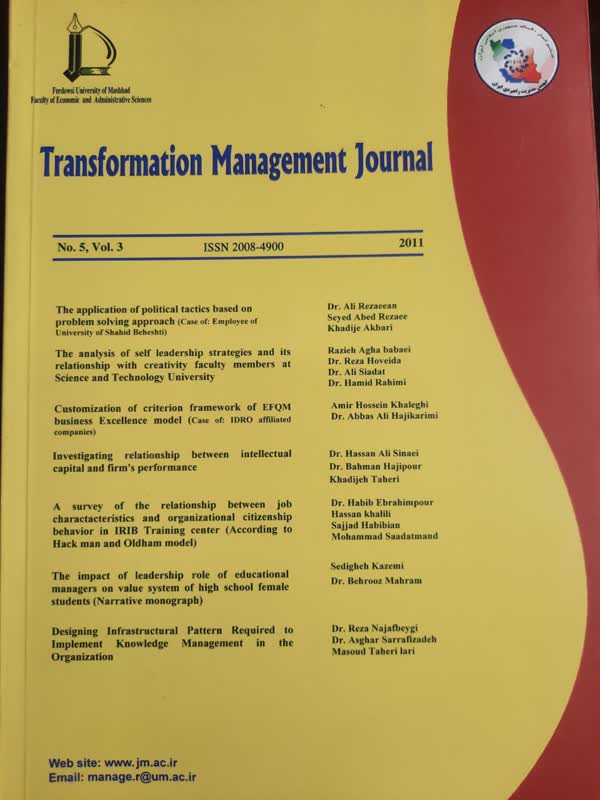Document Type : Articles
Author
Abstract
The main purpose of this research was to investigate self leadership strategies and its relationship with creativity among faculty members at Science and Technology University. Research type was descriptive correlative. Statistical population of research included 345 faculty members at Science and Technology University of Iran in 2009- 2010 academic year. A sample of 119 was selected from research population employing random stratified sampling method. To collect research data, two questionnaires were used: Self- leadership questionnaire with 31 items and Radnsip questionnaire with 48 items. The reliability of questionnaires was determined through calculation of Cronbach alpha coefficients that resulted in 0.81 and 0.87 respectively. Collected data was analyzed at level of inferential statistics (correlation coefficient, multivariate variance and regression). Result of study showed that there is a significant and positive relationship between the Self- leadership behavioural-focused strategies, natural reward strategies, constructive thought strategies and creativity. The result also revealed that, the constructive thought strategies have more important role in predicting creativity.
Keywords
- Abrashoff, D. M. (2001). It's Your Ship: Management techniques form the best dam ship in the Navy. New York, NT: Warner books, Inc.
- Bass, B. M. & Avolio, B. J. (1994). Improving organizational effectiveness through transformational leadership. Thousand Oaks, CA: Sage publication, Inc.
- Elloy, D. (2008). The relationship between self leadership behaviors and organization variables in a self management work team environment, Journal of Management Research News, 31(11), 801-810.
- Ferrel, T. A. (1996). Creativity in the workplace: the impact of work environment. Unpublished doctoral dissertation, Kansas state university (UMI No. 9637231).
- Goleman, D; Boyatzis, R. E. & McKee, A. (2002). Primal leadership. Boston, MA: Harvard business school press.
- Houghton, J.D. & Neck, C.P. (2002). The revised self-leadership questionnaire: testing a hierarchical factor structure for self-leadership, Journal of Managerial Psychology, 17(10), 672-91.
- Houghton, J. D. (2004). The relationship between self- leadership and personality: A comparison of hierarchical factor structures. Journal of Managerial Psychology. 19, 427-441.
- Houghton, J.D. (2006). Two decades of self-leadership theory and research. Past developments, present trends, and future possibilities, Journal of Managerial Psychology, 21(2), 270-95.
- Houghton, J.D. (2008). Self-leadership: A process for entrepreneurial success, Journal of Leadership and Organizational Studies, 13(4), 105-120.
- Houghton, J.D. (2004). Self-Leadership and super leadership: the heart and art of facilitating shared.
- Katz, d. & Kahn, R. L. (1978). The social psychology of organizations. (2nd Ed). Hoboken, N.: Willey & Sons, Inc.
- Kouzes, J, M. & Posner, B, Z. (1995). The leadership challenge, (2nd Ed,). New York: Jessey – Bass.
- Moghimi, M. (1998). Organization and management, (1st ed), Isfahan: publication of Termeh. (in persian).
- Mumford, M. D & Connelly, M. S. (1999). Leadership, encyclopedia of creativity, San Diego, CA: Academic press
- Neck, C. P & Manz, C. C. (2000). Thought self- leadership: The impact of mental strategies training on employee behavior, cognition, and emotion. Journal of Organizational Behavior, 17(3), 445-467.
- Pearce, C, L. (2003). The future of leadership: combining vertical and shared leadership to transform knowledge work. Academy of Management Executive, 12(2), 485-52.
- Polities, john. (2005). Dispersed leadership predictor of the work environment for creativity and productivity, The Journal of Innovation Management, 8(2), 182-204.
- Prussia, G. E. (2002). Self- Leadership and performance outcomes: the mediating influence of self- efficacy. Journal of Organizational Behavior, 19(4), 523-538.
- Roberts, H.E. & Foti, R.J. (2002). Evaluating the interaction between self-leadership and work structure in predicting job satisfaction, Journal of Business and Psychology, 12(3), 257-67.
- Ronsom, A. (1993). Improving higher education in developing countries. The Word Bank
- Shafritz, J. M. & ott, s. J. (2001). Classics of organization theory (5th Ed). Graland, FL: Harcoart, Inc.
- Sheldon, K.M. (2000). Self decision making and creativity, American Psychologist, 56(4), 216-7.
- Yukl, G. A. (2002). Leadership in organizations. Saddle River, NJ: Prentice Hall.

Send comment about this article